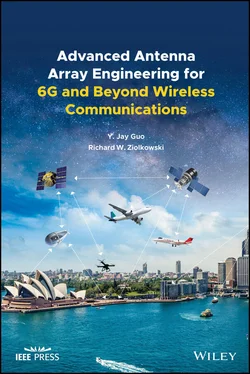1.9 In‐Band Full Duplex Antennas
As frequency resources become more and more scarce, the issue of spectral efficiency has become a top priority for future generations of wireless communication systems. Consequently, in‐band full‐duplex (IBFD) radios are widely regarded as a key technology for the evolution of 5G and 6G systems. IBFD radios allow signal transmission and reception in the same frequency band and at the same time [32]. IBFD radios can double the data rate without using more frequency bands or more time, thus resulting in unprecedented spectrum efficiency enhancement. However, one major issue existing in full‐duplex radios is the suppression of in‐band self‐interference between the transmitters and receivers caused by mismatching at their ports, the mutual coupling between their antenna elements, and the scattering from objects in the environment in which they actually must work.
To realize a practical IBFD radio, the self‐interference from the colocated transmitter must be canceled first as it is typically much stronger than the intended received signal. For IBFD communication systems to operate, it usually requires more than 110–130 dB isolation between the transmitter and the receiver [33]. However, to cancel the self‐interference in IBFD systems satisfactorily, one needs a three‐stage solution in the antenna domain (or propagation domain), the analog domain, and the digital domain.
Clearly, no digital circuits can operate without adequate isolation and appropriate cancelations in the antenna and analog domains to bring the signal‐to‐noise‐and‐interference ratio down to an acceptable level. To this end, major efforts have been made in analog cancelation methods using adaptive circuits and antennas [34–37]. Reported antenna solutions aim to increase the isolation between the transmitter and receiver ports by virtue of spatial and polarization separation, use of metamaterials, and beam squinting. In principle, an ideal solution would be a combination of antenna‐decoupling techniques to be discussed in Chapter 3 and self‐interference cancelation circuits. Major challenges facing antenna researchers and engineers are wide bandwidth, limited antenna space, and low‐loss circuit designs.
Up until the emergence of the third‐ and fourth‐generation mobile wireless communication networks, the focus of most antenna researchers was largely on antennas for radar and satellite communications. On the other hand, antenna designers working in the mobile communication industry were faced with “engineering” challenges largely ignored by the majority of academic antenna researchers. The collocation and coexistence of antennas for 3G and 4G, as well as the demand for antenna miniaturization and stringent specifications, posed serious research challenges to the antenna community. However, judging by the number of publications, one may argue that base station antennas and terminal antennas did not receive the attention they deserved from academic researchers. This lack of attention might have been partly attributed to the unique global industrial landscape formed in that period; the industry was consolidated to only a few players in the end. Moving forward to 5G and 6G, the technology competition among national governments and industries from all around the globe is rapidly gathering pace, thus attracting the widespread interest of the international antennas community. As a result, research on 5G and 6G antennas has started taking center stage globally. In this chapter, we have provided our own perspectives for 5G and 6G antennas. We have outlined some of the major challenges facing antenna researchers and designers, and have enunciated possible technology pathways. In the following chapters, we shall present detailed overviews, and our own studies to address some of the main technical challenges associated with 5G and beyond antenna arrays. We have mainly focused on antennas for base stations and large platforms. Given the potentially vast scope of 5G and 6G systems, we make no claim that all the antenna topics for 5G and beyond have been covered.
1 1. Dang, S., Amin, O., Shihada, B., and Alouini, M.‐S. (2020). What should 6G be? Nat. Electron. 3: 20–29.
2 2. Saad, W., Bennis, M., and Chen, M. (2020). A vision of 6G wireless systems: applications, trends, technologies, and open research problems. IEEE Network 34 (3): 134–142.
3 3. You, X., Wang, C.‐X., Huang, J. et al. (2021). Towards 6G wireless communication networks: vision, enabling technologies, and new paradigm shifts. Sci. China Inform. Sci. 64: 110301. doi. https://doi.org/10.1007/s11432‐020‐2955‐6.
4 4. https://www.5gamericas.org/wp‐content/uploads/2019/08/5G‐Americas_Advanced‐Antenna‐Systems‐for‐5G‐White‐Paper.pdf(accessed 16 January 2020).
5 5. https://www.ericsson.com/en/reports‐and‐papers/white‐papers/advanced‐antenna‐systems‐for‐5g‐networks(accessed 16 January 2020).
6 6. https://carrier.huawei.com/~/media/CNBGV2/download/products/antenna/New‐5G‐New‐Antenna‐5G‐Antenna‐White‐Paper‐v2.pdf (accessed 16 January 2020).
7 7. Han, H., Ding, C., Jones, B., and Guo, Y.J. (2019). Suppression of cross‐band scattering in multiband antenna arrays. IEEE Trans. Antennas Propag. 67 (4): 2379–2389.
8 8. Gu, X., Liu, D., Baks, C., et al. (2017). A multilayer organic package with 64 dual‐polarized antennas for 28 GHz 5G communication. Proceedings of the IEEE International Microwave Symposium (IMS), Honololu, HI, 4–9 June 2017, pp. 1899–1901.
9 9. 5G NR Antenna‐in‐Package (AiP) Technology. White paper. www.tmytek.com(accessed 16 January 2020).
10 10. Huang, X., Hanzo, L., Zhang, A. et al. (2019). Airplane‐aided integrated networking for 6G wireless: will it work? IEEE Veh. Technol. Mag. 14 (3): 84–91.
11 11. Heath, R.W. Jr., González‐Prelcic, N., Rangan, S. et al. (2016). An overview of signal processing techniques for millimeter wave MIMO systems. IEEE J. Sel. Topics Signal Process. 10 (3): 436–453.
12 12. Zhang, J.A., Huang, X., Dyadyuk, V., and Jay Guo, Y. (2015). Massive hybrid antenna array for millimetre wave cellular communications. IEEE Wireless Commun. 22 (1): 79–87.
13 13. Huang, X., Guo, Y.J., and Bunton, J. (2010). A hybrid adaptive antenna array. IEEE Trans. Wireless Commun. 9 (5): 1770–1779.
14 14. Guo, Y.J. and Jones, B. (2018). Base station antennas. In: Antenna Engineering Handbook, fifthe (ed. J.L. Volakis). New York: McGraw Hill, Chapter 40.
15 15. Ansari, M., Jones, B., Zhu, H. et al. (2020). A dual polarized 3D Luneburg lens multi‐beam antenna system. IEEE Antennas Propag. https://doi.org/10.1109/TAP.2020.3044638.
16 16. Guo, Y.J., Huang, X., and Dyadyuk, V. (2012). A hybrid adaptive antenna array for long range mm‐wave communications. IEEE Antennas Propag. Mag. 54 (2): 271–282.
17 17. R4–1807849, 3GPP TSG‐RAN WG4 Meeting #87.
18 18. O'Hara, J.F., Ekin, S., Choi, W., and Song, I. (2019). A perspective on terahertz next‐generation wireless communications. MDPI Technol. 7 (2): 43.
19 19. Mehdi, I., Siles, J., Chen, C.P., and Jornet, J.M. (2018). THz technology for space communications. Proceedings of the 2018 Asia‐Pacific Microwave Conference (APMC), Kyoto, Japan, 6–9 November 2018, pp. 76–78.
20 20. Pasqualini, D. and Maci, S. (2004). High‐frequency analysis of integrated dielectric lens antennas. IEEE Trans. Antennas Propag. 52 (3): 840–847.
21 21. Gao, X., Zhang, T., Du, J., and Guo, Y.J. (2020). 340‐GHz double‐sideband mixer based on antenna‐coupled high‐temperature superconducting Josephson junction. IEEE Trans. THz Sci. Technol. 10 (1): 21–31.
22 22. Costa, J.R., Fernandes, C.A., Godi, G. et al. (2008). Compact Ka‐band lens antennas for LEO satellites. IEEE Trans. Antennas Propag. 56 (5): 1251–1258.
Читать дальше












